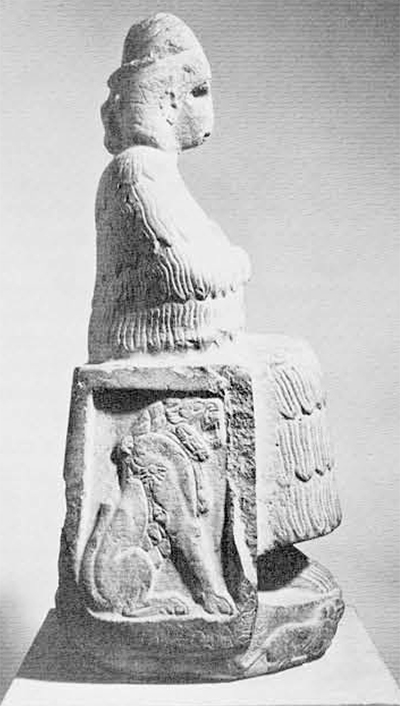
In Sumerian texts we read about the country NIM, the wondrous mountain area which we call Iran today. The biblical name Elam can also be traced to the concept of a highland: elamtu in the language of the Babylonians and Assyrians which referred to the east and northeast of Babylonia. Yet, the most important site of Elam, Susa, was situated in the plain, miles from the mountain ranges which form its hinterland.
As more becomes known about the archaeology and history of Western Asia, the importance of Susa in antiquity emerges more clearly. It was a center of trade and culture for ancient Iran and also for areas far beyond its borders. Relations between protohistoric seal impressions on tablets from Susa and works of predynastic Egyptian art have been repeatedly pointed out. It is not impossible that they reflect the influence of objects brought from Egypt directly or via trading posts in the Gulf. Susa must have also traded with regions far to the east as shown by the excavations at Tepe Yahya where C. C. LambergKarlovsky found tablets with impressions of Proto-Elamite cylinder seals which can be related closely to those known from Susa.
The fortunate geological situation of Susa which assured permanent fertility of the surrounding field was detailed by Robert McC. Adams. The certainty of an adequate food supply which resulted from such rich fields must have contributed to the uninterrupted settlement at Susa from the fourth millennium B.C. to the twelfth or thirteenth century A.D.
The period which is of particular interest here is the one of Elamite rule from the end of the third millennium B.C. to the destruction by Ashurbanipal’s army about 640 B.C. For the reconstruction of the history of this period G. G. Cameron’s History of Early Iran (Chicago, 1936) is still a basic work, more reliable than some of the more fanciful reconstructions of early Elamite history published in recent years.
Important contributions to the elucidation of the still largely enigmatic Elamite language were made by Erica Reiner. Careful translations of Elamite texts of the Persian period were published by R. T. Hallock. The principal works on Elamite art and archaeology, however, have been written by French scholars who had a prerogative for excavations in Iran, especially at Susa and in the regions surrounding that site.
Archaeological investigations of the Elamite levels at Susa were taken up vigorously by Roman Ghirshman in 1946 after many decades of very limited stratigraphic observations by earlier excavators. A summary of the contents of the subsequent levels was presented by Ghirshman within the framework of the Archaeological Seminar at Columbia University (see the American Journal of Archaeology 74, 1970, pp. 223-225). At that time questions were raised by various scholars about the striking and so far unique feature of terracotta heads, male and female, placed beside the head of the deceased, sometimes lying on the side in the natural position of sleep, or, occasionally placed upon the head of the deceased. The last mentioned position seems to have been closely related to the masks placed over the heads, found in earlier excavations of tombs in Susa, according to Pierre Amiet’s description of such burials in his monumental book Elam (Auvers–sur–Oise, 1966).
The importance of Ghirshman’s finds lies in the archaeological context which he provided for these heads by which they are dated in the second half of the second millennium B.C. It would be of the highest interest to discover whether these practices were limited to Susa or whether they were a general Elamite custom. The desirability of finding another Elamite site of urban character like Susa is obvious. The excavations at Haft Tepe carried out under the directorship of Ezat Negahban have not been published in sufficient detail to permit of any general conclusions concerning Elamite funerary or temple architecture other than that of Tchoga Zambil excavated by Roman Ghirshman.
Based on the results of Ghirshman’s excavations at Susa and Tchoga Zambil and on a thorough study of the reports of earlier excavators of Susa, Pierre Amiet was able to present a sequence of styles from which results an overall picture of Elamite art. Little can be added to his enlightening commentaries but a few points may be made concerning three of the major works of Elamite art.
The first, Fig. 1, is the statue of a goddess on a lion throne whose iconography resembles that of the Akkadian goddess Ishtar. The statue, found in a small temple on the “Acropole de Suse” had been dedicated by Puzur-Inshushinak, ensi of Susa and later last king of Awan in the time of the Akkadian king Sharkalisharri (before the collapse of Susa and the Akkadian empire under the attacks of the Guti, tribes located north of Susa, and northeast of Sumer and Akkad). The date of the statue should be placed between 2250 and 2200 B.C. On one side of the throne there is an Akkadian inscription in which, unfortunately, the name of the goddess is not preserved. On the other side of the throne the inscription is in linear Elamite script, indicating Puzur-Inshushinak’s desire to assert the Elamite nature of this votive statue. Walther Hinz read the name of the goddess in this inscription as Narunte. The statue has been intensively discussed by several scholars of whom the last, Agnes Spycket, was able to furnish the figure with its own, very badly battered head which had not been recognized before as belonging to that sculpture. As pointed out by Mlle. Spycket, the head on which traces of a horned miter can be recognized—as well as a diadem most likely made of gold, as was perhaps the covering of the entire face—characterizes the statue as that of a deity, the only one preserved from that period in Western Asia.
This statue is a large and impressive piece of sculpture which shares with works of Akkadian art from Mesopotamia its credible proportions and posture as well as a slight indication of the forms of the body under the garment. An interesting observation by Mlle. Spycket (Syria XLV, 1968, p. 69). concerns the probable decoration of the statue’s ears by gold appliques of a distinctive type related to one found at Mari by Andre Parrot. This suggests connections between Susa and Mari five hundred years earlier than those mentioned in the clay tablets discovered in the archives of the palace at Mari.
Considerable interest also pertains to the lions sculptured on the throne of the goddess.
Three pairs are shown in three different attitudes perhaps indicating slight differences in their functions. The pair in the back (not illustrated here, but see Amiet, Elam, p. 226) stand upright like human guardians, each grasping a spear with his paw drawn much like a human hand with the thumb separated from the other four fingers. The pair on the sides show the lions seated upright on their hindlegs like well-behaved dogs. The pair on the base below the feet of the goddess crouch on either side of a large rosette. All the lions have a mane which leaves the shoulder free for decoration by the much discussed hair whirl-shoulder star which takes here the form of a rosette with less than a full circle of petals. About two hundred years later, in the time of king Shulgi of the Third Dynasty of Ur (ca. 2093-2046 B.C.), a macehead of that king found at Susa (Amiet, Elam, p. 244, Fig. 177) shows the hair whirl in the form of a ribbon tied in a knot from which the two ends hang gracefully. In its manneristic appearance this stylization of the shoulder star may turn out to manifest a distinctive trait of Elamite art.
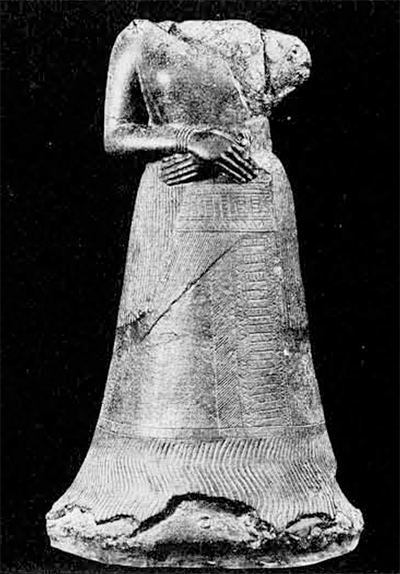
It may be merely accidental that the two great sculptures in the round which have survived at Susa are those of female figures: that of the goddess just discussed and that of queen Napirasu, wife of the Elamite king Untash’Gal, dated about 1260 B.C. (Fig. 2). Yet there can be little doubt about the exceptional position of the queen whose statue was intended to stand alone, not to belong to a composite group in which UntashdGal would have complemented the almost life-size figure of Napirasu. The statue is rightly the most famous work of Elamite art. It conveys an extraordinary expression of permanence, especially if seen from the front with the hands crossed in the middle, creating an accent on the median axis of the sculpture from which the patterns of the robe diverge in an esthetically interesting manner. The abstract bell-shape of the lower part of the figure, contrasting with the restrained naturalism of the upper part, contributes to the impression of immutability created by the statue.
The technical achievement of the Elamite bronze workers in casting this and several other large bronze objects found at Susa, is very impressive. The main decorative features of Napirasu’s statue, the long fringes of the shawl and skirt, the bracelets, the finger-ring, and the brooch in the form of a palmette, were all cast. Subsequent to the casting, a tubelike tool must have been employed to engrave the hundreds of circles with central dot which cover the upper part of the body and part of the skirt. A multitude of patterns with triangles was also engraved on the robe. Some of these patterns look very architectural, especially those combined with columns divided into rectangles suggesting bricks. These and the long straight lines of the fringes of the queen’s shawl contrast strikingly with the softly undulating movement of the fringe around the bottom of the skirt, which almost suggests that it was intended to represent more than a mere textile ornament; one might think of a river surrounding a fortress.
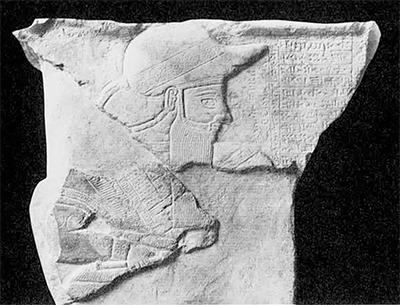
The third major work here considered to be typical of Elamite art is the fragmentary relief of Adda-Hamiti-Inshushinak (Fig. 3) dated about 650 B.C. The king’s figure has the exaggeratedly wide shoulders and narrow waist seen also in Neo-Elamitc rock-reliefs, at Naqsh-i Rustem and near Malamir (Amiet, Elam, p. 562, Fig. 428 and p. 552, Fig. 421). Another similarity with the representations of these rock reliefs concerns the king’s headgear which has a point in front and is tied together in the back. The fact that it is tied suggests that it was made of a piece of cloth, perhaps sewn together in such a way as to leave a flap into which a point, or visor could be introduced. The use of a head-cloth, possibly with a flap and lappets on the sides which could be tied in the back, makes one think of later Scythian headgear. Such a similarity would underscore relations between Elamites and peoples of the Steppes of Central Asia of which a few traces appear in art. Thus, the opposed frontal feline heads of the bracelet worn by Adda-Hamiti-Inshushinak are reminiscent of the frontal feline heads of the large gold plaque from Ziwiye of the seventh century B.C. (see Ann R. Farkas in “Animal Style” Art from East to West. Asia House, 1970, No. 15), for which Aim Farkas and Alexander Soper have independently suggested in conversation that the motif ultimately goes back to the monstrous head of early Chinese iconography, the Tao T’ieh. The most likely intermediaries for the motif would have been tribes of the Central Asiatic Steppes through whom also other motifs appear to have reached the craftsmen responsible for the late Luristan-type jewellery of which the bracelet of Add a-Hamiti-Inshushinak is doubtless an example.
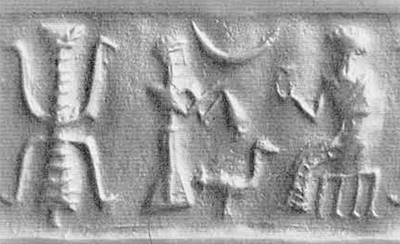
In general, the relief of this king is characteristically Elamite in the mannered stylization of the forms and in the delicate linear ornamentation of the robes. The principal motif of this ornamentation consists of strips of a pattern in which there are two rows of slender triangles pointing toward the middle where there are dots, often combined to form rosettes (though these usually lack a full wreath of petals). Earlier the motif had been employed extensively on the robe of Napirasu. It was probably an easy pattern to engrave and punch on metal, as suggested orally by Machteld J. Mellink. On a Graeco-Roman painting of the early fifth century B.C. discovered by her in a Lycian tomb, the motif occurs in more careful execution, documenting a continuous tradition from Elamite to Persian ornaments.
The classification and understanding of monumental works of Elamite art has been greatly facilitated by our knowledge of well-defined styles of seal engraving, since iconographic motifs and characteristics of style in cylinder seals can often be related to those in larger works of Elamite art. This can be shown in cylinder seals of Old Elamite style (our Figs. 4-6), dated in the first half of the second millennium B.C. Pierre Amiet has established a detailed chronology of this group on the basis of seal impressions on dated tablets. Hitherto partly available in his book Elam (pp. 256-258, 320-323, 330-331) and in an article in Archaeologia No. 36, Sept./Oct. 1970, pp. 22-29, this material will be published by him—together with all cylinders and seal impressions found at Susa from the earliest periods to the Achaemenid—in Memoires de la Delegation archeologique en Iran XLIII.
Amiet called elamite populaire and dated in the nineteenth to eighteenth centuries B.C. the style to which belongs the cylinder of bituminous stone in the Foroughi collection. The enthroned figure, the bird, and the large crescent in the sky all resemble corresponding figures on the cylinder seal of an official of an Elamite king dated after 1850 B.C. and published by Amiet in Archaeologia, Sept./Oct. 1970, p. 25, Fig. 8. The style of the Foroughi cylinder, however, is much cruder, the throne, instead of being a temple throne, seems to have animal feet, and the worshiper, who stands before the enthroned figure without an intermediary, seems to pour a libation from a vessel held upside down with a very awkward gesture. Furthermore, there is a curious form at the end of the scene. It may be a plant with the stem horizontally striated and widening toward the top with two pairs of branches, one curving upward, the other down. The form, however, may also be differently interpreted as a monstrous animal or as a derivative of a divine weapon. The crude style and divergence from forms known in cylinders from Susa of what I call Common Old Elamite style in a translation of Amiet’s term, suggest that this example in the Foroughi collection was made in some provincial locality. Despite these indications of provincial origin, the main features of Elamite iconography are preserved: a scene in which a worshiper offers a sacrifice to an enthroned figure and the gesture of the worshiper who extends both arms (bent at the elbow) toward the deity.
This shows a general knowledge of Common Style Elamite iconography at this period in localities other than Susa. Such localities, however, remain to be discovered.
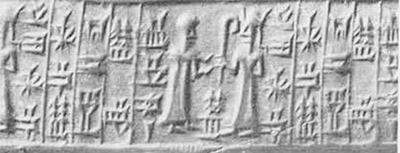
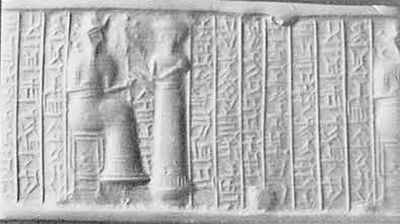
Two cylinders of a more elaborate style which we merely call Old Elamite, are made of more colorful and valuable materials which also permit of finer carving. The first, a very small cylinder, is of a fine dark blue lapis lazuli, the second of orange and white translucent chert. The lapis lazuli cylinder is engraved with the figure of a long-haired god who holds a shepherd’s crook and faces a worshiper who extends his hands toward the deity in a gesture termed above typically Elamite (following Pierre Amiet who, in turn, cited the observation of Father V. Scheil). Both figures wear plain garments; the god’s crown is characterized by a round cap from which the horns curve gracefully outward. This is the most distinctive criterion of Elamite origin because the Babylonians represented the crowns of their gods with horns that curve inward.
Erica Reiner read the inscription as follows:
At-ta-ha-as Attahatuk
tu-uk
DUMU A-pil son of
dMar-tu Apil-Martu
ARAD sa dMar-tu servant of the god Martu
She noted that the last sign was written between the two figures; obviously, the figures were carved first and the inscription fitted in later. Yet, the cylinder was certainly made for the man for whom it was also inscribed, for the god holds a crook, the symbol of the god Martu-Amurru in Babylonia. It is interesting to find that the name and iconography of the god were taken over on a cylinder which is so completely Elamite in style. Style and size of the cylinder resemble those of an example from Tchoga Zambil found in a tomb but without a datable context. Since our cylinder does not parallel closely any of the dated examples published by Pierre Amiet, I suggest placing it in the seventeenth century B.C. on the basis of its small size and extensive inscription which correspond to Babylonian cylinders of that period.
The second cylinder of Old Elamite style, is probably considerably later to judge by the extensive use of the drill for the principal forms. Not only the main vertical shapes of the bodies were hollowed out with this mechanical tool but also the horizontal form which indicates the broad shoulders of the human figures, found in Elamite seals as in Elamite sculpture. It is interesting to compare the silhouete of the worshiper, to which a bell-shaped curve has been added for the fringe at the bottom, with the statue of queen Napirasu with which it shares its abstract, graceful shape.
Well known and characteristically Elamite is the hairdress of the worshiper which projects forward like a visor. Another distinctively Elamite feature is the criss-crossing of thin lines to suggest texture, as seen on the shoulder and arm of the seated deity. A curious feature on this seal is the erasure of part of the god’s ball-staff, over which a small animal, perhaps a dog, has been carved so that it comes to sit above the extended hands of the worshiper. It is impossible to judge whether this was done for the original seal owner or for a secondary one.
Erica Reiner kindly read the inscription:
na-da-an su-ul-mi qa- nadan sulmi
is ba-la-ti su-ul- qais balati sullum
lu-um x ba-ti-nu en-si . . ensi
e-tir ZI TI un-ni-ni etir napisti leqe unnini
it-ti-ka-ma AN.KAL [xi ittikama i-li –ARAD? In-x
Tan-Ru- Tan-Ruburatir
hu-ra-te-ir EANA gar §usi
Su-si u An-za-an
The last line is written between the figures.
Translation:
to give wellbeing, to bestow life, to
safeguard. . ., to protect the weak,
to save life, to accept prayers, is
in your power. (so and so?) . . .
Tan Ruburatir, King of Susa and Anzan.
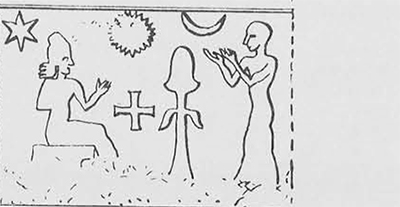
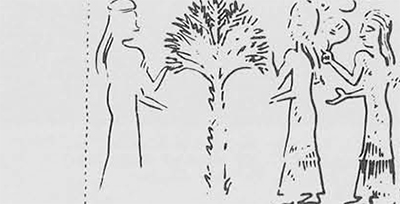
Erica Reiner adds: I cannot read the end of line 5 and the beginning of line 6. Possibly it contains a name and the person’s relationship to Tan-Ruburatir. Note that the parallely built phrases in lines 1-4 which should all be in the form infinitive + genitive, are not alike; at least quais and batinu (perhaps also etir, unless to be read eter) are participles in form.
The full text of Erica Reiner’s commentary has been given here because it conveys to the general reader the difficulties pertaining to translations of Elamite writings. From the style of the elongated figures and the character of the inscription, a date for the cylinder in the sixteenth, perhaps even in the fifteenth century B.C., may be suggested. A king Tan-Ruburatir of this late period remains to be identified.
Seals of the middle Elamite period, from the fifteenth to the twelfth centuries B.C., found at Tchoga Zambil, were assigned to me for study by Roman Ghirshman. They were published in Memoires de la Delegation archeologique en Iran XLII, 1970. Thanks to Pierre Amiet’s generosity, I was also able to examine the contemporary seals and imprints from Susa. There, the cylinders were generally better made than at Tchoga Zambil and larger numbers belonged to what I call the elaborate Elamite style of that period. In neither excavation, however, were examples found of the style represented here by Figs. 7-10, which I would nevertheless like to consider Elamite and which will therefore be examined in some detail.
The first example is a seal impression on a tablet of the fourteenth century B.C. from Assur, published by Thomas Beran in Zeitschrift fur Assyriologie 18 (52), 1957, Fig. 43. Beran noted that the iconography of the imprint did not agree with that of the Middle Assyrian imprints discussed by him. Indeed, scenes in which human or divine figures are represented occur rarely in Assyrian glyptic art of the fourteenth century B.C., and the distinctive gesture of the worshiper with bent arms extended toward the deity characterizes the imprint as having been made with an Elamite cylinder seal. This is confirmed by the radial representation of the sun-disk in Fig. 7 which is reminiscent of a sun symbol on an Elamite cylinder (Mem. Del. en Iran XLII, No. 24), but for which there are no Middle Assyrian parallels. A second fourteenth century imprint from Assur, Fig. 8, shows in the woman with a mirror a likely criterion of Elamite origin. Mirrors were almost ubiquitous in graves of women in the cemetery of Sialk B and, earlier, the goddess on a lion as depicted on the famed Hasanlu bowl, holds a mirror.
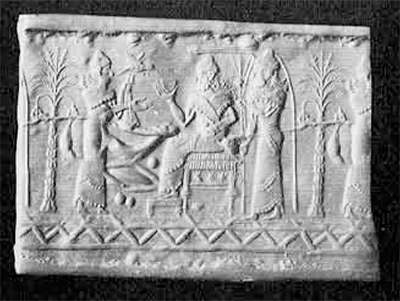
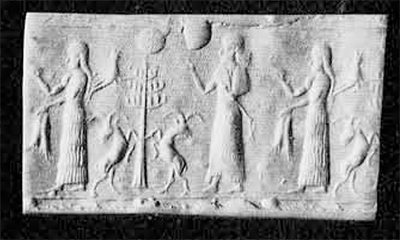
Two cylinder seals, both acquired in Iran, can be related to these two impressions. The first, Fig. 9, in the Foroughi collection, shows an enthroned personage, presumably a ruler, who holds a mace and raises a cup toward which flies a bird of prey. An attendant, standing behind the ruler, holds an umbrella over his head; the other attendant, facing the ruler, extends his hand toward him and raises a towel on which the ruler could wipe his hands. Such scenes which imply the ceremony of a ritual meal are distinctively Elamite.
Originally, the cylinder probably had a gold setting, perhaps with a border of granulated triangles below the base-line of the scene. The seal is now badly chipped; this probably happened when the gold setting was torn off. A crudely carved border of triangles below the scene, a crescent, rhomb, and drillings were inserted on the seal in the late eighth or seventh century B.C. when a drilled style was in fashion. Possibly this barbaric recutting was meant to hide some of the chipping which had occurred earlier. Probably at the time of the recutting, a bronze pin was introduced into the perforation of the cylinder, a device for suspension common in Neo-Assyrian cylinder seals. The cylinder was broken in half, probably in modern times, and a chip which included the middle part of the attendant’s figure on the left, was incorrectly replaced so that this figure lacks the naturalistic outline of the back seen in the attendant at the right.
In spite of all this damage, one can still appreciate the beauty of this cylinder seal with its delicate naturalistic detail and abundant ornamentation blended with remarkable skill. All three persons wear the same kind of wrapped garment with borders of small globes, but the ruler has additional fringe and appliqués: he also wears a large earring with a pendant and his hair seems to hang down the back in curls, whereas the hair of the attendants is a little bushier and shorter. The ruler’s seat resembles in its complicated structure, furniture portrayed on the so-called situlae from Luristan (dated several centuries after our cylinder), which I consider to have been Elamite rather than Babylonian.
The design of the palm tree which terminates the scene in Fig. 9 closely resembles palms engraved on an ivory comb and a situla found at Assur. Like the cylinders impressed in Figs. 7 and 8, however, these ivories could have been imported from Elam.
The second cylinder seal, Fig. 10, closely resembles the imprint, Fig. 8, in the long-haired woman with a flounced skirt and in the compositional motif of two figures flanking a tree. Although the male figure in the present cylinder seal wears a robe with ladder-shaped borders which differ from those of Fig. 9, the subject of a person carrying a towel, the free composition, and several distinctive details such as the short edge of fringe visible above the foot of the person carrying a mace like that of the ruler in Fig. 9, suggest that both cylinders originated in the same place, from which also must have come the originals of Figs. 7 and 8. Another cylinder of the same group, also found at Assur (Anton Moortgat, Vorderasiatische Rollsiegel, Berlin, 1940, No. 527), is made of glass, a material rarely used for cylinders outside of Iran; glass seals are particularly numerous at the Elamite sites of Tchoga Zambil and Susa. A cylinder, formerly De Clercq No. 359, now in the Louvre, which also belongs to this group, is made of a stone unknown to me from any Mesopotamian examples. The material of some of the extant seals of this group thus supports the classification suggested on the basis of stylistic considerations, according to which the cylinders originated in Elam.
In the ornamental use of natural forms and their extraordinarily graceful lines, the designs of these cylinders foreshadow those of the NeoElamite period of which the chalcedony cylinder, Fig. I I, is an example.
Erica Reiner read the inscription as follows:
pa?-KUR DUMU Pi-in-ri-
ri-na
Kikapa?-KUR son of Pinririna
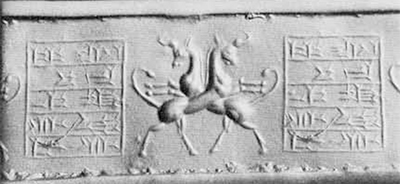
On this cylinder, the lightly stepping bulls, whose bodies are decoratively crossed and seem to be weightlessly raised, nevertheless convey an image of strength and dignity by their muscled bodies and proudly arched necks. The seal thus represents the most distinctive and enduring qualities of Elamite style.
Yet, though much has been learnt about Elamite art, we do not know the source of those seals which could reveal most about fife at court in Elam in the fourteenth century B.C., here represented by Figs. 7-10. Thus, much still remains to be discovered about Elamite art and archaeology.
In the present essay, many names of scholars were mentioned who have contributed ideas on the subject of Elamite art. This demonstrates the wide interest in this art as well as the method of cooperation and free exchange of ideas which has become customary in this field owing to the initiative and continued but always self-effacing activity of Robert 1-1. Dyson, Jr.
—E.P.
